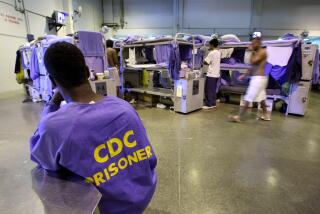Governor’s Plan to Reduce Jobs Becoming Major Issue
- Share via
SACRAMENTO — One of the biggest issues emerging in Gov. George Deukmejian’s proposed 1985-86 state budget is his plan to cut 2,869 more positions from the state work force by the end of the next fiscal year.
The governor says that would mean a reduction of 6,000 budgeted positions since he took office in 1983.
Are the cuts real? Or is the Republican chief executive playing an accounting game?
Those questions have been raised during an initial round of hearings on Deukmejian’s proposed $33.6-billion spending plan and have triggered some of the earliest partisan debate between the Deukmejian Administration and lawmakers and their chief fiscal adviser.
The issue is important, not only because it raises questions about possible understaffing of state agencies, but because it would represent a historic turnaround in the steady pattern of the growth of state employment. Every year since 1950, with three exceptions, the number of state employees has risen.
One exception was in the 1978-79 fiscal year, the year of the cuts forced by passage of the tax-cutting initiative Proposition 13 in 1978. The other two times state employment dropped were in fiscal years 1982-83 and 1983-84, in response to a state fiscal crisis.
This time around, however, the proposed cuts in state employment are philosophical, in keeping with Deukmejian’s desire to cut state government.
Though the state is back in good financial health after the 1983 fiscal crisis, a fact symbolized by a $1-billion surplus, the Deukmejian program for the upcoming fiscal year proposes cutting 2,869 positions on top of those trimmed in his first two budgets. That would mean a reduction of about 1% from the 230,757 positions authorized in the current budget.
But Sen. John Garamendi (D-Walnut Grove), who sits on a key Senate budget committee, recently heated up a budget hearing by accusing state Finance Director Jesse R. Huff of using “fiction” and “playing games” with numbers to come up with the 6,000 figure.
Tough Job Foreseen
And Legislative Analyst William G. Hamm, the Legislature’s chief budget adviser, claims that an actual head count of state employees over the same period would actually show a 1,200 increase in full-time positions, rather than a decrease.
He said Senate and Assembly budget committees “will have their hands full trying to make sense out of the numerous proposals to reduce the number of state employees that are contained in the budget.”
Deukmejian Administration officials say, however, that their critics in the Legislature are off base, and raise the possibility that Democrats may be several steps behind the governor. They say, if anything, that the estimates of the number of jobs to be cut may be on the conservative side.
“We are not filling all the positions we are authorized to fill. We have captured 6,000 authorized positions. That’s a fact. We have achieved that,” said Steven A. Merksamer, Deukmejian’s chief of staff, during an interview.
Other Administration officials back him up.
Using a variety of techniques, ranging from holding open jobs that become vacant through retirements or transfers, to the introduction of computers and other high-tech hardware to do jobs once done by hand, to contracting with private and other public agencies for work now done by state employees, Administration officials seem to be uniformly working toward significant reductions in the work force.
At stake for Deukmejian is whether he will be able to deliver on his 1982 campaign promise to reduce the size of state government.
Chances of Success
While his budgets have increased substantially year to year--his proposed $33.6-billion budget for 1985-86 represents a 25% increase in three years--Deukmejian, if he is successful, will be able to point to a historic turnaround in state employment.
But will he be successful?
All indications are that he will be, although an official head-count of state employees for the current year is still months away and the number of actual jobs in the upcoming budget year will not be known until late 1986.
What seems to be throwing many off the track are the historic games that have been played in counting government employees.
Because budgets anticipate spending 18 months into the future, they necessarily represent estimated numbers of positions. Traditionally, these estimates are infla-ted, for political as well as practical purposes.
Inflating numbers allows public officials to claim they are cutting back when actually they are growing or holding even. For example, an agency may budget 100 positions but fill only 90, allowing the manager to claim he cut 10 positions. Or he may hire three new employees, but cut seven positions, allowing him to say he cut back even when his agency was actually growing.
What Deukmejian officials are saying is that the cuts this time are for real.
Effect on Services
Sen. Alfred E. Alquist (D-San Jose), chairman of the Senate Budget and Fiscal Review Committee, said the real issue is not the total number of cuts but the effect the cuts will have on the level of service being provided by departments hit hardest by employee reductions.
Mentioning two departments on the governor’s hit list, the Employment Development Department and the Department of Motor Vehicles, Alquist said: “Judging by the letters I’m receiving, the quality of service in EDD and DMV is deplorable.”
Since Deukmejian’s first budget in 1983-84, the departments losing the largest numbers of employees are the Employment Development Department, the overseer for the distribution and collection of unemployment benefits, which stands to lose 3,035 positions (23% of its work force) by the end of the 1985-86 fiscal year; the Department of Transportation, responsible for the state highway system, which would lose 611 positions (3.9%), and the University of California, which faces a loss of 1,214 jobs (2.1%).
An analysis by the California State Employees Assn. shows that in his proposed budget for next year, Deukmejian recommends cuts in positions in 53 departments, while recommending increases in 17. Association President Leo E. Mayer calls the cuts “brutal.”
Administration officials claim that improved efficiencies and increases in actual budget dollars are allowing them to improve service to the public even while they cut back on the number of state employees. They also say the reduction in the work force will be accomplished with no layoffs.
Kaye R. Kiddoo, director of the Employment Development Department, said two-thirds of the cuts in his department are due to reduced demand for services for the jobless because of the drop-off in unemployment. Other cuts are attributed to private sector-type management changes.
Kiddoo, a retired aerospace executive, said the Administration already has committed about $30 million to buy computers and other high-tech hardware to automate the department and hopes to get another $14 million. He estimates that 540 positions in the upcoming budget will be reduced because of “administrative efficiencies, automation and the streamlining of operations.” Gary D. Macomber, director of the Department of Developmental Services, which administers eight state hospitals and provides services for 7,500 severely disabled Californians, said his department would lose 626 positions under the proposed budget, a 4.5% cut.
But he claimed that the cuts would have no effect on services and are achieved entirely through continued reductions in the state hospital population and other savings and efficiencies. Some cost-cutting measures he mentioned were contracting with the prison system to do more laundry for state hospitals; cooking meals during the week and then heating them on weekends, rather than operating full kitchens on weekends; transferring responsibility for some alcohol-treatment programs to counties and cutting administrative jobs.
More to Read
Get the L.A. Times Politics newsletter
Deeply reported insights into legislation, politics and policy from Sacramento, Washington and beyond. In your inbox twice per week.
You may occasionally receive promotional content from the Los Angeles Times.










